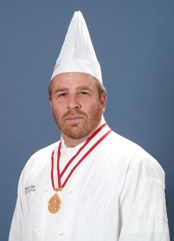Celebrating Diversity in the Culinary Classroom
Super UserThe method is the constant, and the ingredients are the variables.
By Samuel Glass, CEC, CCE, CCA
 As the demographic of culinary schools shifts to a much more multicultural environment, embracing and celebrating cultural diversity is becoming part of the everyday life of culinary institutions. The challenge for culinary instructors is in finding a way to integrate cultural diversity into the curriculum in a tacit manner, one in which students might not recognize the true objectives, yet at the same time, achieve a sense of accomplishment and pride in their own cultural heritage and cuisine.
As the demographic of culinary schools shifts to a much more multicultural environment, embracing and celebrating cultural diversity is becoming part of the everyday life of culinary institutions. The challenge for culinary instructors is in finding a way to integrate cultural diversity into the curriculum in a tacit manner, one in which students might not recognize the true objectives, yet at the same time, achieve a sense of accomplishment and pride in their own cultural heritage and cuisine.
One of the mantras that I have always used as a culinary educator is, “The method is the constant and the ingredients are the variables.” Keeping that mantra in mind, I have found a way to celebrate the diversity of my students, while meeting the objectives of the curriculum.
When teaching this class, one of my objectives is showing students that a good cook/chef is the one who can take an inexpensive cut of meat or poultry and, through braising, turn it into something wonderful and sell it for a decent price, thus achieving a lower food cost. In my experience, the two dishes most often used to demonstrate braising techniques are osso buco and chicken cacciatore. These are both classic dishes, founded on Italian cuisine. However, with the culturally diverse background of today’s culinary classroom, maybe we, as educators, should be looking at different dishes that are braised, representative of our student’s culture, and that also meet our learning objectives.
Several years ago, as part of an “Iron Chef” competition, I gave each of my students two chicken legs as the “mystery ingredient” to braise. The objective, quite simply, was to have the students demonstrate their competencies in braising. Much to my surprise, the class became an exercise not only in braising, but one of cultural diversity and flavors.
My diverse class consisted of students with backgrounds from the Philippines, Sri Lanka, India, Pakistan, Jamaica, Trinidad, Guyana, Latin America, Italy, France, China and North America. Each student prepared a braised chicken-leg dish based on his/her background and presented it to not only me, but their fellow students to taste and critique. The students took ownership of their learning. They demonstrated their competencies in braising (which was the core objective) while sharing their ethnic pride, heritage and flavors with their classmates. Rather than learn the taste of one dish, such as chicken cacciatore, the students experienced several different tastes from around the world, all founded on braising, without leaving the classroom.
As for who created the best dish and won the competition, it was a student of French-Canadian heritage, who prepared a curry using the braised chicken legs. A far cry from her background, but at the same time proving my assertion that most dishes can be cooked keeping in mind that “The method is the constant and the ingredients are the variables.”
_________________________________________________________________________________
Glass is a proud Canadian graduate of The Culinary Institute of America (1982). Having worked in kitchens throughout the world, he currently is teaching at Centennial College’s (Toronto, Ontario) School of Hospitality, Tourism and Culture. A member of both the American Culinary Federation and the Canadian Culinary Federation (CCFCC), Glass was the 2005-2006 Chef of the Year for the Central Region of the CCFCC, and received an ACF President’s Medallion for his contributions to the culinary profession. Glass has published several articles on both culinary curriculum and kosher cuisine and also volunteers as a mentor through the Adopt-A-Ship program with the U.S. Navy. In addition to his ACF certifications, he is a certified TrainCan Sanitation instructor and holds a bachelor’s degree in adult education. Most recently, he was inducted into the ACF’s honor society, the American Academy of Chefs.
Leave a comment
Make sure you enter all the required information, indicated by an asterisk (*). HTML code is not allowed.

